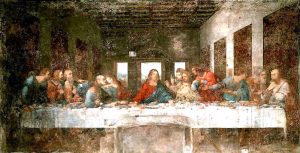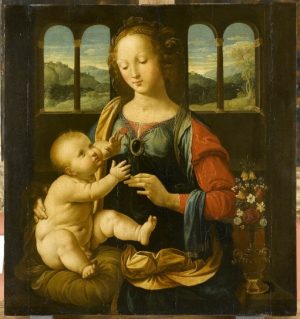Lady with an Ermine by Leonardo da Vinci
Lady with an Ermine is a painting by Leonardo da Vinci from around 1489–1490. The subject of the portrait is Cecilia Gallerani, painted at a time when she was the mistress of Ludovico Sforza, Duke of Milan, and Leonardo was in the service of the duke. The painting is one of only four portraits of women painted by Leonardo, the others being the Mona Lisa, the portrait of Ginevra de’ Benci, and La belle ferronnière. The Lady with an Ermine is a portrait painting widely attributed to the Italian Renaissance artist Leonardo da Vinci.
Mona Lisa by Italian Artist Leonardo da Vinci
The Mona Lisa is a half-length portrait painting by Italian artist Leonardo da Vinci. Considered an archetypal masterpiece of the Italian Renaissance, it has been described as “the best known, the most visited, the most written about, the most sung about, the most parodied work of art in the world”.
Saint John the Baptist by Italian Artist Leonardo da Vinci
Saint John the Baptist is a High Renaissance oil painting on walnut wood by Leonardo da Vinci. Likely to have been completed between 1513 and 1516, it is believed to be his final painting. Its original size was 69 by 57 centimetres. The painting is in the collection of the Louvre.
The Mona Lisa is a half-length portrait painting by Italian artist Leonardo da Vinci. Considered an archetypal masterpiece of the Italian Renaissance, it has been described as “the best known, the most visited, the most written about, the most sung about, the most parodied work of art in the world”.
The Last Supper by the Italian High Renaissance artist Leonardo da Vinci
The Last Supper is a mural painting by the Italian High Renaissance artist Leonardo da Vinci, dated to c. 1495–1498
Two aspects of the Last Supper have been traditionally depicted in Christian art: Christ’s revelation to his Apostles that one of them will betray him and their reaction to this announcement, and the institution of the sacrament of the Eucharist with the communion of the Apostles.
The Virgin and Child with a Carnation by Leonardo da Vinci
The Madonna of the Carnation, also known as the Madonna with Vase, Madonna with Child or Virgin with Flower, is a Renaissance oil painting by Leonardo da Vinci created around 1478–1480. It is permanently displayed at the Alte Pinakothek gallery[2] in Munich, Germany.
The central and centered motif is the young Virgin Mary seated with Baby Jesus on her lap. Depicted in sumptuous clothes and jewellery, with her left hand Mary holds a carnation (red, suggesting blood and the Passion). The faces are put into light while all other objects are darker, e.g. the flower is covered by a shadow. The child is looking up and the mother looking down, with no eye contact. The setting of the portrait is a room with two windows on each side of the figures.






